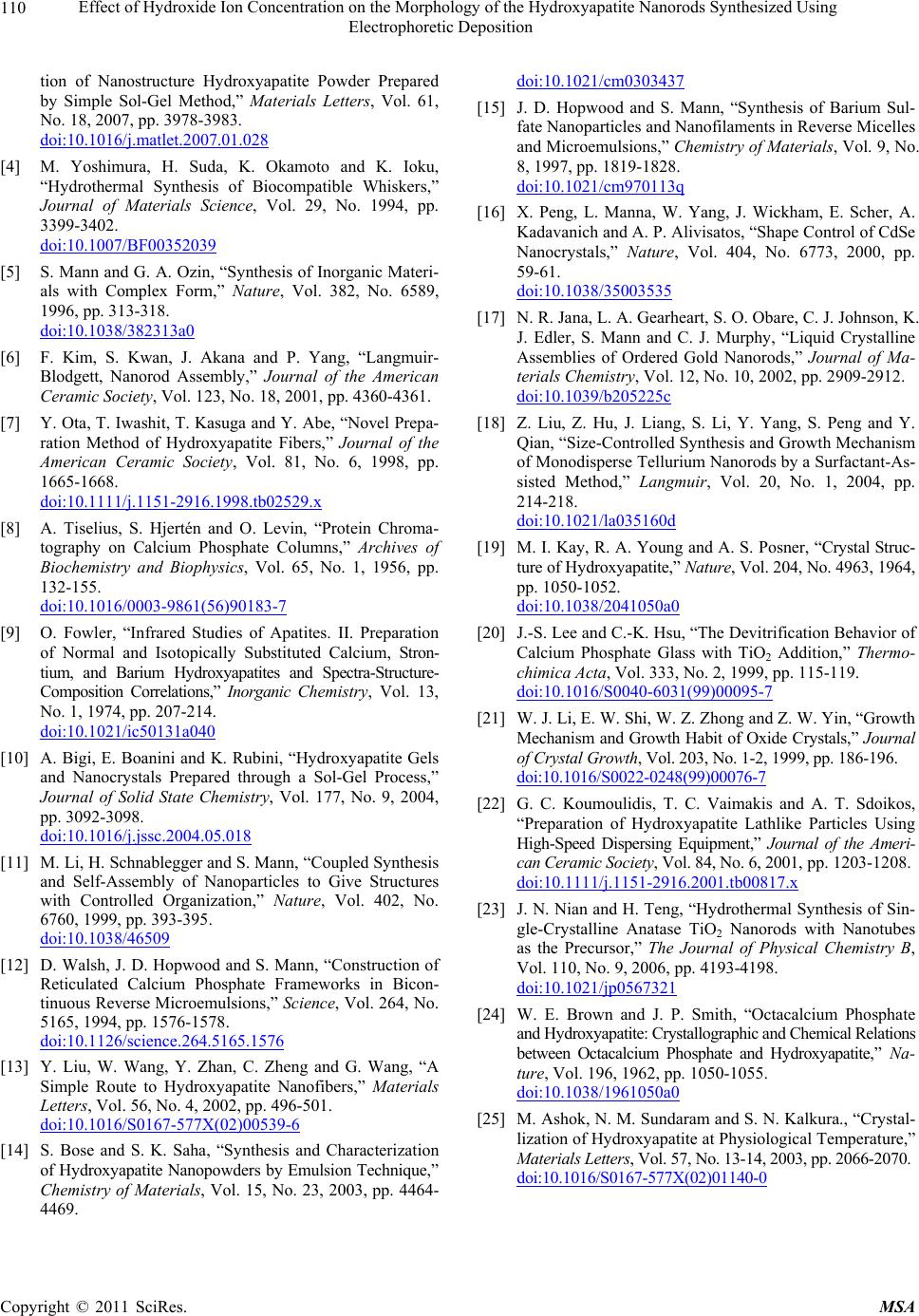
Effect of Hydroxide Ion Concentration on the Morphology of the Hydroxyapatite Nanorods Synthesized Using
Electrophoretic Deposition
Copyright © 2011 SciRes. MSA
110
28
tion of Nanostructure Hydroxyapatite Powder Prepared
by Simple Sol-Gel Method,” Materials Letters, Vol. 61,
No. 18, 2007, pp. 3978-3983.
doi:10.1016/j.matlet.2007.01.0
kamoto and K. Ioku[4] M. Yoshimura, H. Suda, K. O,
“Hydrothermal Synthesis of Biocompatible Whiskers,”
Journal of Materials Science, Vol. 29, No. 1994, pp.
3399-3402.
doi:10.1007/BF00352039
Synthesis of Inorganic Materi-
a0
[5] S. Mann and G. A. Ozin, “
als with Complex Form,” Nature, Vol. 382, No. 6589,
1996, pp. 313-318.
doi:10.1038/382313
kana and P. Yang, “Langmuir-
151-2916.1998.tb02529.x
[6] F. Kim, S. Kwan, J. A
Blodgett, Nanorod Assembly,” Journal of the American
Ceramic Society, Vol. 123, No. 18, 2001, pp. 4360-4361.
[7] Y. Ota, T. Iwashit, T. Kasuga and Y. Abe, “Novel Prepa-
ration Method of Hydroxyapatite Fibers,” Journal of the
American Ceramic Society, Vol. 81, No. 6, 1998, pp.
1665-1668.
doi:10.1111/j.1
rotein Chroma-
/0003-9861(56)90183-7
[8] A. Tiselius, S. Hjertén and O. Levin, “P
tography on Calcium Phosphate Columns,” Archives of
Biochemistry and Biophysics, Vol. 65, No. 1, 1956, pp.
132-155.
doi:10.1016
tites. II. Preparation [9] O. Fowler, “Infrared Studies of Apa
of Normal and Isotopically Substituted Calcium, Stron-
tium, and Barium Hydroxyapatites and Spectra-Structure-
Composition Correlations,” Inorganic Chemistry, Vol. 13,
No. 1, 1974, pp. 207-214.
doi:10.1021/ic50131a040
[10] A. Bigi, E. Boanini and K. Rubini, “Hydroxyapatite Gels
c.2004.05.018
and Nanocrystals Prepared through a Sol-Gel Process,”
Journal of Solid State Chemistry, Vol. 177, No. 9, 2004,
pp. 3092-3098.
doi:10.1016/j.jss
Synthesis [11] M. Li, H. Schnablegger and S. Mann, “Coupled
and Self-Assembly of Nanoparticles to Give Structures
with Controlled Organization,” Nature, Vol. 402, No.
6760, 1999, pp. 393-395.
doi:10.1038/46509
[12] D. Walsh, J. D. Hopwood and S. Mann, “Construction of
1576
Reticulated Calcium Phosphate Frameworks in Bicon-
tinuous Reverse Microemulsions,” Science, Vol. 264, No.
5165, 1994, pp. 1576-1578.
doi:10.1126/science.264.5165.
g and G. Wang, “A [13] Y. Liu, W. Wang, Y. Zhan, C. Zhen
Simple Route to Hydroxyapatite Nanofibers,” Materials
Letters, Vol. 56, No. 4, 2002, pp. 496-501.
doi:10.1016/S0167-577X(02)00539-6
[14] S. Bose and S. K. Saha, “Synthesis and Characteriz
21/cm0303437
ation
of Hydroxyapatite Nanopowders by Emulsion Technique,”
Chemistry of Materials, Vol. 15, No. 23, 2003, pp. 4464-
4469.
doi:10.10
ann, “Synthesis of Barium Sul-[15] J. D. Hopwood and S. M
fate Nanoparticles and Nanofilaments in Reverse Micelles
and Microemulsions,” Chemistry of Materials, Vol. 9, No.
8, 1997, pp. 1819-1828.
doi:10.1021/cm970113q
[16] X. Peng, L. Manna, W. Yang, J. Wickham, E. Scher, A.
38/35003535
Kadavanich and A. P. Alivisatos, “Shape Control of CdSe
Nanocrystals,” Nature, Vol. 404, No. 6773, 2000, pp.
59-61.
doi:10.10
eart, S. O. Obare, C. J. Johnson, K. [17] N. R. Jana, L. A. Gearh
J. Edler, S. Mann and C. J. Murphy, “Liquid Crystalline
Assemblies of Ordered Gold Nanorods,” Journal of Ma-
terials Chemistry, Vol. 12, No. 10, 2002, pp. 2909-2912.
doi:10.1039/b205225c
[18] Z. Liu, Z. Hu, J. Liang, S. Li, Y. Yang, S. Peng and Y.
/la035160d
Qian, “Size-Controlled Synthesis and Growth Mechanism
of Monodisperse Tellurium Nanorods by a Surfactant-As-
sisted Method,” Langmuir, Vol. 20, No. 1, 2004, pp.
214-218.
doi:10.1021
and A. S. Posner, “Crystal Struc-
050a0
[19] M. I. Kay, R. A. Young
ture of Hydroxyapatite,” Nature, Vol. 204, No. 4963, 1964,
pp. 1050-1052.
doi:10.1038/2041
The Devitrification Behavior of [20] J.-S. Lee and C.-K. Hsu, “
Calcium Phosphate Glass with TiO2 Addition,” Thermo-
chimica Acta, Vol. 333, No. 2, 1999, pp. 115-119.
doi:10.1016/S0040-6031(99)00095-7
[21] W. J. Li, E. W. Shi, W. Z. Zhong and Z. W. Yin, “Growth
Mechanism and Growth Habit of Oxide Crystals,” Journal
of Crystal Growth, Vol. 203, No. 1-2, 1999, pp. 186-196.
doi:10.1016/S0022-0248(99)00076-7
[22] G. C. Koumoulidis, T. C. Vaimakis and A. T. Sdoikos,
“Preparation of Hydroxyapatite Lathlike Particles Using
High-Speed Dispersing Equipment,” Journal of the Ameri-
can Ceramic Society, Vol. 84, No. 6, 2001, pp. 1203-1208.
doi:10.1111/j.1151-2916.2001.tb00817.x
[23] J. N. Nian and H. Teng, “Hydrothermal Synthesis of Sin-
gle-Crystalline Anatase TiO2 Nanorods with Nanotubes
as the Precursor,” The Journal of Physical Chemistry B,
Vol. 110, No. 9, 2006, pp. 4193-4198.
doi:10.1021/jp0567321
[24] W. E. Brown and J. P. Smith, “Octacalcium Phosphate
and Hydroxyapatite: Crystallographic and Chemical Relations
between Octacalcium Phosphate and Hydroxyapatite,” Na-
ture, Vol. 196, 1962, pp. 1050-1055.
doi:10.1038/1961050a0
[25] M. Ashok, N. M. Sundaram and S. N. Kalkura., “Crystal-
lization of Hydroxyapatite at Physiological Temperature,”
Materials Letters, Vol. 57, No. 13-14, 2003, pp. 2066-2070.
doi:10.1016/S0167-577X(02)01140-0